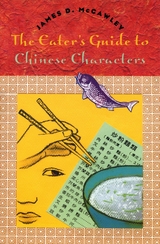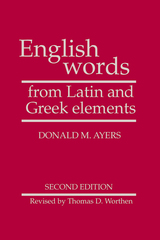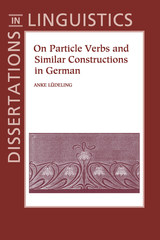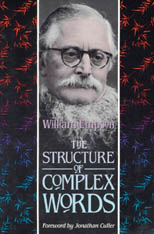5 books about Word formation

The Eater's Guide to Chinese Characters
James D. McCawley
University of Chicago Press, 1984
Lauded by Calvin Trillin as a man who "does not have to make to with translations like 'Shredded Three Kinds' in Chinese restaurants," in The Eater's Guide to Chinese Characters, James D. McCawley offers everyone a guide to deciphering the mysteries of Chinese menus and the opportunity to enjoy new eating experiences. An accessible primer as well as a handy reference, this book shows how Chinese characters are written and referred to, both in script and in type. McCawley provides a guide to pronunciation and includes helpful exercises so users can practice ordering. His novel system of arranging the extensive glossary—which ranges from basics such as "rice" and "fish" to exotica like "Buddha Jumps Wall"—enables even the beginner to find characters quickly and surely. He also includes the nonstandard forms of characters that often turn up on menus.
With this guide in hand, English speakers hold the key to a world of tantalizing—and otherwise unavailable—Chinese dishes.
With this guide in hand, English speakers hold the key to a world of tantalizing—and otherwise unavailable—Chinese dishes.
[more]

English Words from Latin and Greek Elements
Donald M. Ayers; Revised by Thomas D. Worthen
University of Arizona Press, 1986
Since 1965, Donald Ayers' English Words from Latin and Greek Elements has helped thousands of students to a broader vocabulary by showing them how to recognize classical roots in modern English words. Its second edition, published in 1986, has confirmed that vocabulary is best taught by root, not rote. The importance of learning classical word roots is already acknowledged by vocabulary texts that devote chapters to them.
Why a whole book based on this approach? Ayers' text exposes students to a wider range of roots, introduces new English words in context sentences, and reinforces vocabulary through exercises. It promotes more practice with roots so that students learn to use them as tools in their everyday encounters with new words. English Words is written from the standpoint of English; it neither attempts to teach students Latin or Greek nor expects a knowledge of classical languages on the part of instructors. Its success has been demonstrated at both the secondary and college levels, and it can be used effectively with students in remedial or accelerated programs.
An Instructor's Manual (gratis with adoption) and a Workbook are also available.
Why a whole book based on this approach? Ayers' text exposes students to a wider range of roots, introduces new English words in context sentences, and reinforces vocabulary through exercises. It promotes more practice with roots so that students learn to use them as tools in their everyday encounters with new words. English Words is written from the standpoint of English; it neither attempts to teach students Latin or Greek nor expects a knowledge of classical languages on the part of instructors. Its success has been demonstrated at both the secondary and college levels, and it can be used effectively with students in remedial or accelerated programs.
An Instructor's Manual (gratis with adoption) and a Workbook are also available.
[more]

On Particle Verbs and Similar Constructions in German
Anke Lüdeling
CSLI, 2001
Linguistic distinctions between the notions of a phrase, a word, and their components are challenged by so-called particle verbs in German and similar features in other languages. Particle verbs look like single words, yet are typically assembled from word-like fragments that together behave more like components of a phrase than of a word. The resolution of existing scholarly ambivalence has exciting ramifications, from questioning the existence of particle verbs to a broader understanding of what constitutes a word.
Particle verbs have previously been analyzed as morphological objects or as phrasal constructions, but neither approach fits cleanly within its chosen framework. The resolution presented here is that particle verbs should be seen as lexicalized phrasal constructions. Emphasizing morphological and syntactic testability, over a hundred colloquial examples are shown to break the rules of previous approaches while remaining consistent with this book's proposition. To distinguish particle verbs from similar constructions, and to demonstrate how structural and morphological factors have been misidentified in the past, preverb verb constructions (PVCs) are introduced and diagrammed. This reveals the roles of listedness and non-transparency in word formation and clarifies the conclusion that particle verbs do not form a definable class of words.
Particle verbs have previously been analyzed as morphological objects or as phrasal constructions, but neither approach fits cleanly within its chosen framework. The resolution presented here is that particle verbs should be seen as lexicalized phrasal constructions. Emphasizing morphological and syntactic testability, over a hundred colloquial examples are shown to break the rules of previous approaches while remaining consistent with this book's proposition. To distinguish particle verbs from similar constructions, and to demonstrate how structural and morphological factors have been misidentified in the past, preverb verb constructions (PVCs) are introduced and diagrammed. This reveals the roles of listedness and non-transparency in word formation and clarifies the conclusion that particle verbs do not form a definable class of words.
[more]

Samskrta-Subodhini
A Sanskrit Primer
Madhav M. Deshpande
University of Michigan Press, 1999
Saṃskṛta-Subodinī: A Sanskrit Primer marks the culmination of Professor Deshpande’s experience of teaching Sanskrit at the University of Michigan for over twenty-five years. Tested in classes at Michigan and elsewhere and successively improved for over twenty years, the teaching materials in the book now offer an effective tool to learn and teach Sanskrit. The focus is Sanskrit as a language, rather than as a religious or mystical entity. Deshpande’s primer also simplifies the process of learning Sanskrit by dissociating this language-learning process from the heavy burdens imposed both by the tradition of Indo-European linguistics and the tradition of indigenous Sanskrit grammarians in India. By treating Sanskrit as a productive language, rather than as a dead language merely to be deciphered, the book represents a significant advance over the traditional Western approach to the study of Sanskrit.
Work on this book began in 1976, and now almost two generations of Professor Deshpande's students have used successively improved versions. The book’s examples include many modified versions of classical Sanskrit passages from epic texts such as the Mahabharata and the Ramayana. The book also contains examples from Hindu, Buddhist, and Jain traditions, as well as samples of Sanskrit poetry and satire.
[more]

The Structure of Complex Words
William Empson
Harvard University Press, 1989
READERS
Browse our collection.
PUBLISHERS
See BiblioVault's publisher services.
STUDENT SERVICES
Files for college accessibility offices.
UChicago Accessibility Resources
home | accessibility | search | about | contact us
BiblioVault ® 2001 - 2024
The University of Chicago Press









